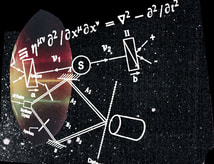 100 years have passed since the quantum realm was first breached by these physicists, who worked together without the technology we take for granted now. Televisions had just been invented. Telephones were in early stages of development, with the first transatlantic call being made in 1927. They relied heavily on letters and meetings in person. They worked tirelessly on problems in their own institutions. And finally they came to a grinding halt with a unilateral verdict that quantum mechanics was not to be fully understood and if it ever was, it would transform physics beyond recognition.  Here in 2020, we are barely out of the mist. Vast, expensive experiments like the LHC and Super-K have been created to test, trap and interpret the movement of sub-atomic particles, bringing data agreeing or not with 'expected parameters', that's most often seen to follow a bell-curve close to the predicted line. But there's a stumbling block, one that moves unseen through marble halls and sticks to academia like wit to a blanket... a block people talk about but somehow fail to see as such, patting it reassuringly with a fondly held belief that it should somehow be there. Confirmation bias is prevalent in physics because this is a science reliant on equations. In the early 1900s, equations created to describe quantum mechanics adopted codes taken from ancient Greek, among other sources, as new thoughts led to new symbolism for the new particles, forces and factors being brought to light. While these updates in language were arising, prejudice against the unknown ran rife, and much store was set by any constant or constraint that could be identified as limiting what particles could do. Quantum mechanics was squeezed into a box, from which it had little chance of escape. So it firmly said, instead, that nobody would ever understand it. The atom itself is a case in point. The image sitting amid the quotes above is a classical view of what an atom would look like, with electrons neatly orbiting a tidy little nucleus tucked in the centre. This view has been trawled through a grinder by the Uncertainty Principle, a wide-ranging (but commonly constrained) tour de force that prevents anything from being exactly anywhere, and may also prevent the same thing ever happening twice (hence uniqueness in snowflakes and grains of sand). So these days, the atom is viewed as a fuzzy groupage of indeterminables, except in the number of electrons, protons and neutrons contained within it. These components of sub-structure are all subject to continuous change. Electrons jump up and down in energy levels (via interaction with photons), protons and neutrons are interchangeable, and the quarks they are comprised of turn from one 'flavour' and 'colour' to another in a constantly shifting sea of mass that is impossible to pin down. So far, so good. Things have not so much become clearer, as become less tangible.  We've reached a point now wherein physicists are preparing themselves for New Physics, and many are exploring depths never before plumbed - into the realms of consciousness and what constitutes the bedrock of our indeterminable reality. Their theories and findings are still hard-hit by confirmation bias, meeting the battle-cry of "Woo, it's all Woo," with swords from a sheath of "pseudo-science" readily drawn against an onslaught of unknown variables. Impeccable pedigrees, PhDs and peer reviews appear to be no protection against Trolls, declaring themselves as guardians of all that's respectable in the world of quantum mechanics, even though that world is largely comprised of uncharted territory in very deep waters indeed. What do you see, beyond the smoke and mirrors? Come and join the Group to discuss.
0 Comments
Leave a Reply. |
AuthorKathy is the author of Quantumology. She met up with quantum mechanics in 1997, pledging allegiance to its sources thereafter. These are her personal thoughts and testimonies. Archives
April 2023
|
 RSS Feed
RSS Feed